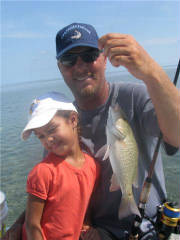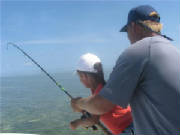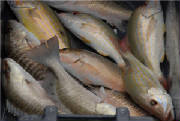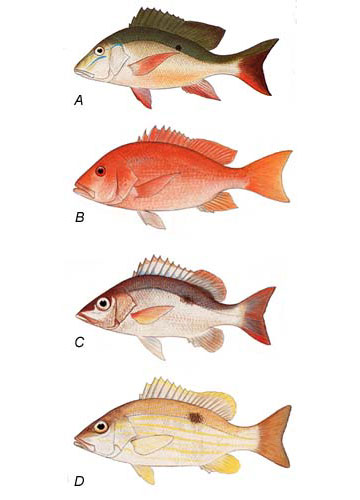|
|
key west offers a host of fish
in the snapper family. these fish are abundant year round and are favorite targets when fishing with children.the non stop
action will keep children entertained and help them to have a enjoyable experience. the following is infomation on types,
sizes, and feeding habits.
Any of about 250 species of valuable food fishes (family Lutjanidae), found throughout the tropics. These active schooling fishes have slender bodies, large mouths, sharp canine teeth, and blunt or forked tails. Many species grow to 2 – 3 ft (60 – 90 cm) long. Snappers eat crustaceans and other fishes. mutton snapper Large adults are found in or near
offshore reef and rock rubble habitats, while the juveniles live in inshore areas. The juveniles are abundant in shallow waters
such as tidal mangrove creeks, canals, and shallow protected bays, utilizing turtle grass as bottom cover. Solitary adults
can be found among rocks and reefs, while juveniles occur over sandy or sea grass bottoms. Once an adult mutton snapper becomes
established in an area, they tend to remain there. Small aggregations of mutton snapper may form during the day, disbanding
at night. These fish may be found at depths ranging from 80 - 310 feet. The feeding habits of the mutton snapper change during their life history. Larval snappers feed on plankton near the surface of the water. As they settle out into the shallow grass beds, they begin to feed on larger plankton and small invertebrates. The diet then switches to shrimp, snails, crabs, and small fish such including mullet and small grunts. gray snapper The gray snapper is one of the smaller snappers,
rarely exceeding 18 inches (45 cm) in length, and is almost always less than10 pounds. Maximum size is 24 inches and 10lbs.
Gray snapper are opportunistic predators. Juvenile gray snappers feed by day among seagrass beds, mainly on crustaceans
and fish and to a lesser degree polychaete worms and molluscs. Foraging nocturnally, adult gray snapper prey upon small fishes,
shrimps, crabs, gastropods, and cephalopods
lane snapper Adult lane snappers live in a variety of habitats,
but are most commonly observed over reefs and vegetated sandy bottoms in shallow inshore waters. This species has also been
reported in offshore waters to depths of 1300 feet (400 meters). Once established, adult snappers remain in the same area
for their entire lives. Lane snappers also occur in seagrass beds associated with shrimping areas. Juveniles live in protected
inshore areas.Lane snappers have an average length of 14 inches (36 cm), with a maximum length of 20 inches (50 cm). They
usually weigh less than a pound. Sexual maturity is reached at lengths of 3-9 inches (10-23 cm). The estimated maximum age
of the lane snapper is 10 years. Because the lane snapper lives in a wide range of habitats, they are opportunistic predators,
feeding on a variety of prey. Lane snappers feed nocturnally on smaller fishes, shrimp, cephalopods, gastropods, and crabs.
|
Enter supporting content here





